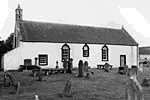|
|
|
|
|
Travel To The Old Fermtoun Of Kilmany In Fife, Scotland
An old fermtoun village in NE Fife, situated by the A914 3 miles (5 km) north of Cupar. Dr Thomas Chalmers (1780-1847), church leader and first moderator of the Free Church after the Disruption of 1843, was minister (1803-15) of Kilmany Parish church which dates from 1768. The church was originally a rectory of St Salvator's College in St Andrews and in its churchyard lies buried the Earl of Melville who supported William and Mary's claim to the throne in 1689. To the east stands the tower of Kinnear which lies on land occupied by the Kinnear family for over 700 years.
Scotland has many tales of white and green ladies. Fife is no exception. Gouls Den, Kilmany, is a ravine that lies a little to the north-west of Kilmany Cottage. If you have the courage to venture here at the witching hour you are apt to see "white ladies" and other shades of the departed, who found Kilmany so beautiful they haunt it yet.
Jim Clark, the famous racing driver, was born on a farm in Kilmany. The youngest of the family, and the only boy among four sisters, Jim moved to a Border districts farm, Edington Mains near Duns, Berwickshire, at the age of six. Jim Clark succeeded in the World Driver's Championship, the Indianapolis 500 and Indy car racing, the British and European Touring Car Championships, the Tasman Cup, the British and European Formula Two Championships, won races in the Lotus 23B and the difficult Lotus 30 sports cars, and proved adept at rallying and even NASCAR racing. On many occasions he raced in several classes during a Grand Prix meeting.
Jim Clark died in 1968 aged 32. To those of us who followed his career in international motor racing, his death on April 7 in a Formula Two race at Hockenheim, Germany, was unbelievable. His apparent good humour and consummate skill seemed indestructible. In Kilmany, on June 6, 1997, Jackie Stewart unveiled an impressive bronze statue of Jim Clark. The statue is of Jim striding down the pit lane in his overalls - apparently based on Jim's mother's favourite picture of him.
Extract from A descriptive & historic gazeteer of the counties of Fife, Kinross & Clackmannan, M Barbieri, published in 1857.
"This parish is bounded on the north by Forgan and Balmerino, on the south by Cupar and Logie, on the east by Forgan and on the west by Creich and Moonzie. The Eden river separates it from Leuchars. It is 6 miles from east to west and 2 miles north to south. Its area is 4700 acres; 3550 Scotch acres are under cultivation and 250 are under wood. The west part of the parish consists of softly swelling hills and pleasant valleys. The parish is divided at different places by small ridges, the highest not exceeding 400 feet above sea level. The soil varies but generally is very fertile. Rent of land averages £2-5-0 per acre. Within the last 75 years more than 200 acres of morass have been drained. A good deal of cattle of the Fife breed are raised and sold fat; a great number of sheep are annually fed on turnips for the butcher. There are 17 thrashing mills, besides 3 corn mills and 1 saw mill. There is no coal in the parish, it being brought from Ceres or Cameron. Apart from the sawmill and about a dozen of weavers, there is no industry in the parish. The parish school is at Rathillet, with 2 female schools, one at Hazleton and one at Kilmany.There are 2 public houses. There is no village but 2 hamlets - Kilmany, half way between Cupar and Newport, where the parish church is situated; and Rathillet which is a mile to the west. The late celebrated Dr Chalmers was minister of Kilmany from 1803 to 1815."
If you would like to visit this area as part of a highly personalized small group tour of my native Scotland please:
e-mail me today
Or why not visit my extensive
Travel Scotland
Web site at:
Travel Scotland
Home Page
|
|
|
|
|

